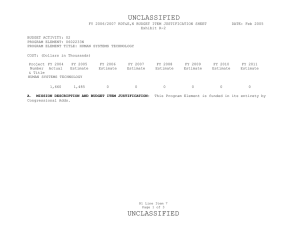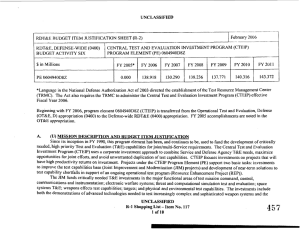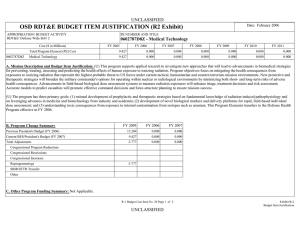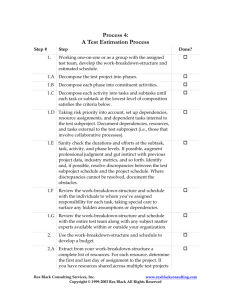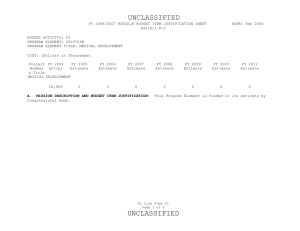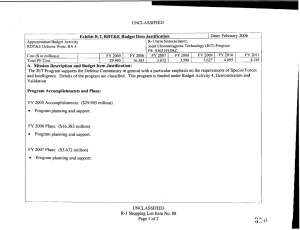UNCLASSIFIED
advertisement
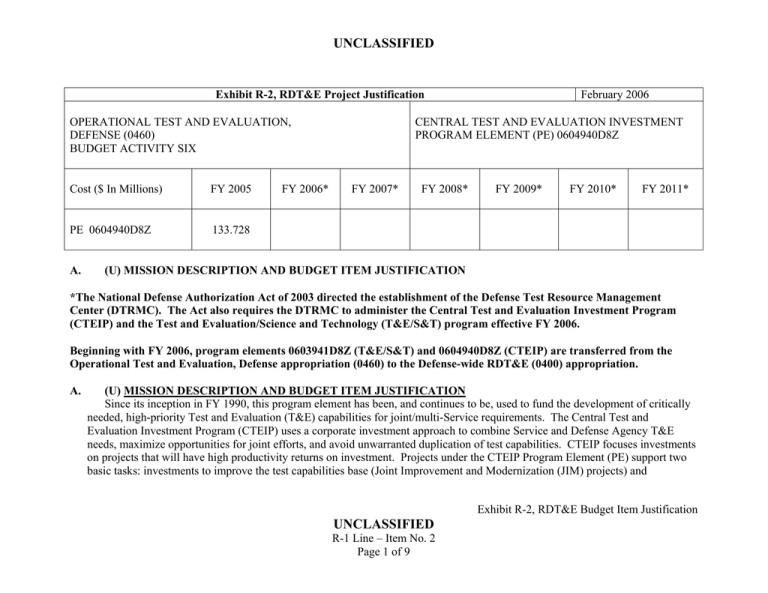
UNCLASSIFIED February 2006 Exhibit R-2, RDT&E Project Justification OPERATIONAL TEST AND EVALUATION, DEFENSE (0460) BUDGET ACTIVITY SIX Cost ($ In Millions) FY 2005 PE 0604940D8Z 133.728 A. FY 2006* CENTRAL TEST AND EVALUATION INVESTMENT PROGRAM ELEMENT (PE) 0604940D8Z FY 2007* FY 2008* FY 2009* FY 2010* FY 2011* (U) MISSION DESCRIPTION AND BUDGET ITEM JUSTIFICATION *The National Defense Authorization Act of 2003 directed the establishment of the Defense Test Resource Management Center (DTRMC). The Act also requires the DTRMC to administer the Central Test and Evaluation Investment Program (CTEIP) and the Test and Evaluation/Science and Technology (T&E/S&T) program effective FY 2006. Beginning with FY 2006, program elements 0603941D8Z (T&E/S&T) and 0604940D8Z (CTEIP) are transferred from the Operational Test and Evaluation, Defense appropriation (0460) to the Defense-wide RDT&E (0400) appropriation. A. (U) MISSION DESCRIPTION AND BUDGET ITEM JUSTIFICATION Since its inception in FY 1990, this program element has been, and continues to be, used to fund the development of critically needed, high-priority Test and Evaluation (T&E) capabilities for joint/multi-Service requirements. The Central Test and Evaluation Investment Program (CTEIP) uses a corporate investment approach to combine Service and Defense Agency T&E needs, maximize opportunities for joint efforts, and avoid unwarranted duplication of test capabilities. CTEIP focuses investments on projects that will have high productivity returns on investment. Projects under the CTEIP Program Element (PE) support two basic tasks: investments to improve the test capabilities base (Joint Improvement and Modernization (JIM) projects) and Exhibit R-2, RDT&E Budget Item Justification UNCLASSIFIED R-1 Line – Item No. 2 Page 1 of 9 UNCLASSIFIED development of near-term solutions to test capability shortfalls in support of an ongoing operational test program (Resource Enhancement Project (REP)). The JIM funds critically needed T&E investments in the major functional areas of test mission command, control, communications and instrumentation; electronic warfare systems; threat and computational simulation test and evaluation; space systems T&E; weapons effects test capabilities; targets; and physical and environmental test capabilities. The investments include both the demonstrations of advanced technologies needed to test increasingly complex and sophisticated weapon systems and the transition of these technologies into test capabilities. Examples of project subject matter include: automated data collection, processing, display, and archiving; smart munitions testing; modeling and simulation (M&S); advanced electronic combat systems; low-observable technologies and signature measurements; targets and target control; Time-Space-Position Information (TSPI); end-game measurement; testing of advanced materials application; test design; and advanced sensors and space systems. CTEIP continues as the focal point for fostering common architectures throughout the test and training communities to enhance the sharing of resources and links between test and training ranges. CTEIP has provided special focus to institutionalize the use of M&S as a practical test tool; to link ranges through internet to enhance inter-range and inter-Service cooperation and resource sharing; and, to ensure development and acquisition of common instrumentation necessary for a more efficient test infrastructure. Analyses of alternative solutions are conducted for each investment project to validate T&E requirements, to define integrated support systems, and to determine overall cost effectiveness of the proposed test investments. The use of Department of Defense (DoD)-wide criteria for requirement validation, prioritization, and risk assessment ensures an effective test resource investment program. The REP funds development of near-term solutions for critical ongoing operational tests supporting decisions on major, highpriority defense acquisition programs. These unanticipated operational test (OT) capability requirements arise from several sources such as a new threat system identified during OT planning, acquisition of foreign military assets that are critical in determining weapon system operational effectiveness, short timelines between system design maturity and scheduled OT, and emerging technologies and test requirements resulting from operational concept changes mandated by Congress or DOT&E, or system-of-systems testing. Funding these activities under the CTEIP provides the opportunity to coordinate and integrate these near-term test requirements with the total DoD test and evaluation investment planning, and ensures their availability and legacy for other programs that may have similar testing requirements. This PE also funds travel to carry out oversight of the CTEIP program. Exhibit R-2, RDT&E Budget Item Justification UNCLASSIFIED R-1 Line – Item No. 2 Page 2 of 9 UNCLASSIFIED This Research Category 6.4 PE supports the development and application of proven technologies to provide major test and evaluation capabilities required to meet DoD component weapon system test requirements. Program Accomplishments and Plans: FY 2005 Accomplishments: JIM Projects: Completed the project to develop and demonstrate a new generation of rugged, miniaturized, onboard instrumentation applicable to smart munitions flight tests, within the Hardened Sub-Miniature Telemetry and Sensor System Product Improvement project. Completed development of the Roadway Simulator capability for tractor-trailer combination testing. Completed concept development and initiate systems development for improved test and evaluation capabilities for directed energy weapons. Completed development of system enhancements under the Airborne Separation Video project. Completed the Electromagnetic Transient Test and Evaluation Facility project to provide a capability to assess aircraft hardness to electro-magnetic transient environments to meet Military Standard 464 requirements. Completed the Tri-Service Signature Measurement and Database System project to provide the capability to characterize the detailed spatial, spectral, and temporal signatures of aircraft, missiles, ground vehicles, ships, undersea vehicles, and their countermeasures in realistic environments. Completed the requirements documentation and development of a roadmap for future investments under the Digital Video Systems Development project to provide DoD test and evaluation facilities and ranges new capabilities to collect, process, store, and distribute data from high-performance digital imagery systems. Completed the Multi-Service Target Control System project to provide upgraded target control systems that meet triService requirements. Completed standardization of the Test and Training Enabling Architecture (TENA) object model and the development of software tools and integration products within the Foundation Initiatives 2010 project. Completed the Missile Engagement Threat Simulator project to develop an enhanced capability to evaluate the vulnerability of aircraft to Man-Portable Air Defense Systems (MANPADS). Completed concept development and initiate systems development for the Joint Mobile Infrared Countermeasures Test Exhibit R-2, RDT&E Budget Item Justification UNCLASSIFIED R-1 Line – Item No. 2 Page 3 of 9 UNCLASSIFIED - - - - - - System project to provide infrared spectrum test instrumentation for open air ranges. Completed concept development and initiated systems development for the Unmanned Systems Testbed project, to provide capabilities for using unmanned systems in training, operational exercises, and test and evaluation. Continued systems development of the Electromagnetic Environment Effects Generating System project to provide a multi-test facility capable of assessing actual performance of a full-scale, fixed, or rotary-winged aircraft completely immersed in a user-specified radio frequency environment. Continued development of the Airborne Icing Tanker project to develop an airborne icing capability for testing various DoD aircraft systems at both high and low altitude, suitably presenting natural rain and icing conditions. Continued the Digital Video Laboratory project to provide digital video data analysis and reporting capability. Continued validation of flight test procedures and unmanned aerial vehicle (UAV) operations in the U.S. National Airspace alongside manned aircraft, under the UAV Systems and Operations Validation Facility Program. Continued the Land and Sea Vulnerability Test Capability project to provide an instrumented land-sea interface test capability at the Aberdeen Test Center. Continued systems development of the Contamination Avoidance Detector Test Suite project to provide test methodology, instrumentation, and test fixtures required to test and evaluate current and developmental chemical/biological (CB) detector systems over the entire range of expected use conditions. Continued the development and demonstration of time-space-position information (TSPI), flight termination/safe and arm (FTSA), and telemetry functions on advanced missile platforms under the Joint Advanced Missile Instrumentation project. Continued systems development of the Joint C4ISR project to develop a capability to test increasingly complex multidiscipline fusion concepts. Continued the Infrared Sensor Stimulator product improvement, the Advanced Radar Environment Stimulator project, and the Communications, Navigation, and Identification follow-on under the Joint Installed Systems Test Facility Product Improvements project, to provide improved installed systems capabilities needed to support next generation aircraft testing. Continued systems development of the Soft Impact Location Capability project to provide the necessary instrumentation, signal processing, communication, and data processing capabilities to detect and locate the point and angle of impact of projectile and missile weapons within an 800m by 800m impact area. Continued systems development of the Enhanced Flight Termination System project to develop a UHF digital flight termination system for DoD unmanned flight vehicles. Exhibit R-2, RDT&E Budget Item Justification UNCLASSIFIED R-1 Line – Item No. 2 Page 4 of 9 UNCLASSIFIED - - - - - Continued systems development of the Advanced Instrumentation Data & Control System project to develop state-ofthe-art instrumentation and control systems to meet DoD T&E requirements for propulsion systems, aerodynamic systems, and space systems. Continued systems development of the Enhanced Range Applications Project to provide a state-of-the-art Airborne Range Data System that supports next generation data collection requirements. Continued threat system simulator development efforts under the Threat System Simulator Development project to improve integration reduce potential duplication in threat and target development, and ensure that accurate, costeffective representations of threat systems are available to support testing. Continued the Service and CTEIP support projects. Initiated concept development for the Integrated Network Enhanced Telemetry project to develop a network-enhanced telemetry capability for T&E ranges and facilities. Initiated concept development for the Hypersonic Propulsion Test Capability project to provide a variable Mach number test capability at the Arnold Engineering Development Center. Initiated the Test and Training Enabling Architecture (TENA) Software Development Activity project to develop software enhancements and integration tools. Initiated and completed the Film Elimination project to decrease reliance on wet film imagery and to facilitate the transition to digital systems. Initiated the Joint Gulf Range Complex Upgrade project to provide upgraded range control capabilities and the Gulf Range. Initiated proof-of-concept effort for a capability to test airborne infrared countermeasure systems in a dynamic threat environment, to include realistic clutter background. Initiated concept development for the Joint Information Assurance/Web-Enabled Test project to provide a dynamic Information Assurance test tool suite with the ability to conduct extensive testing of web-based systems. Initiated concept development for the Interactive Electronic Attack project to provide an interactive electronic attack radio frequency capability to test electronic warfare, communications, and avionics systems against reactive air defenses in a secure, protected ground-based environment. Initiated concept development for the Advanced Communications Environment—Faithful Timeslot Messaging project to adapt the current Joint Communications Simulator antenna pattern and propagation effects to provide timeslot dependent attenuation of Link-16 terminal output. Initiated concept development for the Test Capability Workstation/Data Collection Automation Tool project to develop a software suite and tools that focus on Capabilities-Based Test methodology to support operational test planning and Exhibit R-2, RDT&E Budget Item Justification UNCLASSIFIED R-1 Line – Item No. 2 Page 5 of 9 UNCLASSIFIED the automation of test data collection, analysis, and reporting. Initiated concept development for a warhead compatible, universal, subminiature, low-cost flight termination system. Initiated and completed concept for a project to develop advanced non-intrusive/embedded instrumentation capability Resource Enhancement Project: Completed the Advanced Mine Simulation System subproject to provide significant improvements to existing threat mine simulation test capabilities. Continued the Advanced System Endgame Methodology for Actual Threat Systems subproject to develop and integrate emerging technology for high fidelity, real-time endgame assessment for threat system engagements in support of Comanche operational testing. Completed the Commander Air Defense Environment Test Tool subproject to develop a test tool to emulate, stimulate and evaluate the Single Integrated Air Picture Command, Control, Communications, Computers, and Intelligence (C4I) system-of-systems in support of the Area Air Defense Commander. Completed the Threat Signals A subproject to develop and implement new threat surface-to-air missile system signals in the Joint Communications Simulator to ensure testing in an operationally dense and coherent scenario based environment. Completed the Dense Environment Radio Frequency Injection subproject to develop and implement a radio frequency signal simulator system to provide direct injection of a dense RF environment into the system under test Completed the Seeker Integration subproject to characterize and integrate recently received foreign hardware into the Electronic Combat Range (ECR) at China Lake, CA, to support ongoing electronic countermeasure testing Completed the Shallow Water Antisubmarine Warfare (ASW) Target subproject to modify an existing, manned dieselelectric Completed the National Warning Network Scenarios and Test Tools subproject to build scenarios, test drivers and test tools for new operational test requirements resulting from real-world events and recent program and threat changes. Completed the Voice/Video Emulation Test Tool subproject to develop two digital voice emulation systems to stimulate and evaluate voice and video transmissions from realistic operational ranges in support of tactical command and control systems. Completed the SIIRCM Instrumentation Suite subproject to upgrade the Super Multi-role Electro-Optic Simulator to incorporate a night vision camera, multi-band laser detector, and laser range finder to simulate characteristics of UV and IR signatures. Completed the Supersonic Sea Skimming Target (SSST) Stream Raid subproject to provide two Anti-Ship Cruise Exhibit R-2, RDT&E Budget Item Justification UNCLASSIFIED R-1 Line – Item No. 2 Page 6 of 9 UNCLASSIFIED - - - - - Missile threat targets with near simultaneous arrivals on similar bearings to resolve the system track management, coordinated combat direction, and survivability critical operational issues (COIs). Completed the Time Space Position Information (TSPI) Advanced Tracker subproject to upgrade the current TSPI Advanced Tracker (TAT) with range acquisition radar to increase its ability to acquire and track targets at greater distances, in low light, and in obscured weather. Completed the Expeditionary Fighting Vehicle (EFV) Threat Vehicle Surrogate Targets subproject to develop 2½-D IR plastic ground surrogate targets to emulate the appearance, thermal signature, and mobility of BMD-2, BMP-2, BTR70, and BRDM-2 threat vehicles. Completed the Small Contingency Theater Positioning System subproject to develop a system that will enable time, space, and position information of test assets in environments encountered under small contingency operations (Military Operation Urbanized Terrain, urban, mountains, caves, etc.). Completed the Foreign Targets Surrogate subproject to develop eight threat mine surrogates for use in COMOPTEVFOR operational tests and assessments of Mine Countermeasure systems. Completed the Supersonic Sea Skimming Target (SSST) Enhanced Maneuverability subproject to upgrade the GQM163A target design to perform square wave inputs to perform terminal weaves which will more closely represent threat anti-ship missile maneuvers. Initiated the Advanced Capability Mobile Flight Simulator subproject to to provide more realistic Tactical Ballistic Missile (TBM) threat scenario simulations. Initiated the and completed Expeditionary Fighting Vehicle (EFV) Force On Force Real Time Casualty Assessment (RTCA) Test Instrumentation subproject to leverage off an existing instrumentation system to provide an improved operational test capability. - - - Initiated and completed the Field Referee of Low Concentrations of MS2 and OV Bio Aerosols subproject to modify a high volume aerosol collection instrument capable of collecting low concentrations of bio aerosols simulating actual threat agents. Initiated the Information Assurance(IA) Susceptibility Testing for Global Air Traffic Management Avionics (GATM) subproject to expand an existing capability to support BLOS GATM and ground system information assurance testing. Initiated the Probability of Raid Annihilation (PRA) Testbed Common Threat and Environment Capability subproject to develop a common set of threat and natural environment representations for consistent assessment of SSDS across ship classes. Initiated the Torpedo Proximity Scoring System subproject to develop a reliable and flexible prototype instrumentation system to support torpedo defensive system testing and evaluation requirements. Exhibit R-2, RDT&E Budget Item Justification UNCLASSIFIED R-1 Line – Item No. 2 Page 7 of 9 UNCLASSIFIED - - - - Initiated the Distributed Operational Test Command Center subproject to provide a distributed test control capability that integrates communications, data processing and test monitoring, and visual displays systems into a single capability. Initiated the Test Control Communications Capability subproject to provide an integrated communications suite of hardware, software, and firmware protocols to provide realistic command, control, and communications testing. Initiated the Shootable Remote Threat Ground Targets subproject to provide six low cost ground targets operating in a tactical formation and an integrated portable autopilot and remote control system. Initiated the Magnetic Silencing Facility subproject to provide improved magnetic component calibration and adequate operational testing of the Advanced Degaussing System on new ship classes. Initiated the Air and Missile Defense Operational Test Suite subproject to provide the capability to automatically collect, transfer, store and analyze data for Combatant Commander’s Integrated C2 System and the Ground-based Midcourse Defense operational and interoperability testing. Initiated the Decontamination Ground Truth Instrumentation subproject to provide instrumentation capable of measuring chemical and biological warfare simulants and interferents to assess decontamination effectiveness. Initiated the Portable Oceanographic Environmental Sensors Instrumentation Suite subproject to support the testing of amphibious weapon systems requiring detailed and automated data collection within the oceanographic environment. FY 2006 Plans: NA FY 2007 Plans: NA Exhibit R-2, RDT&E Budget Item Justification UNCLASSIFIED R-1 Line – Item No. 2 Page 8 of 9 UNCLASSIFIED B. (U) PROGRAM CHANGE SUMMARY ($ in Millions) FY 2005 FY 2006 President's Budget 133.728 FY 2007 President’s Budget 133.728 FY 2006 FY 2007* Total Adjustments Congressional program reductions Congressional rescissions Congressional increases Fiscal Guidance Adjustments Inflation Adjustment Reprogramming C. (U) OTHER PROGRAM FUNDING: NA D. (U) PERFORMANCE METRICS Please see PE 0604940D8Z in 0400 for FY 2005 actuals and discussion. Exhibit R-2, RDT&E Budget Item Justification UNCLASSIFIED R-1 Line – Item No. 2 Page 9 of 9

